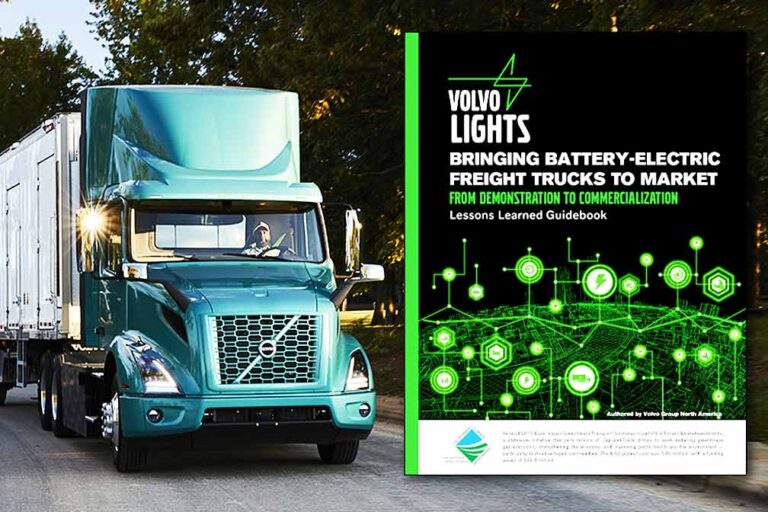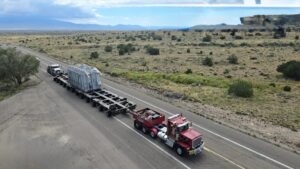GREENSBORO, N.C. — Volvo Group North America (VGNA) has published a new book outlining what company officials call key insights into the testing of its battery-electric VNR model.
The Lessons Learned Guidebook is designed to commemorate the end of the company’s three-year electric rig testing project though Volvo LIGHTS (Low Impact Green Heavy-Transport Solutions), which began in 2019 and concludes in early Fall 2022.
Volvo LIGHTS is part of California Climate Investments, a statewide initiative that puts billions of Cap-and-Trade dollars to work reducing greenhouse gas emissions, strengthening the economy and improving public health and the environment — particularly in disadvantaged communities. The total project cost is $90 million, with a funding award of $44.8 million.
Throughout the project, the trucks and equipment are estimated to have facilitated weighted emission reductions of NOx, ROG and PM by an estimated 3.57 tons per year. according to VGNA.
Over 10 years, that equates to 35.7 tons of weighted emission reductions of these pollutants.
Further, the project produced an estimated 1.86 million kWh of renewable electricity, the majority of which was used to charge the electric trucks and displace 207,000 diesel gallons equivalent of fossil fuel annually, VGNA officials said.
This produced estimated reductions of 3,020 metric tons of GHG emissions annually or 30,200 metric tons of GHGs over a 10-year period.
“By participating in the Volvo LIGHTS project, our team gained incredibly valuable experience that helped shape the comprehensive customer support model for our Volvo VNR Electric model, which was first commercialized in December 2020,” Peter Voorhoeve, president of Volvo Trucks North America, said.
“That said, we know that the transition away from diesel to electric power will involve far more than developing reliable truck technology. The Volvo LIGHTS project helped underscore the many areas in which public and private entities will need to collaborate to develop the ecosystem needed to support customers with successful battery-electric truck adoption – including the build out of public and private charging infrastructure, a robust dealer support network, incentives and strategies to reduce costs, a trained workforce of technicians, sales consultants, first responders and more.”
The Volvo LIGHTS project, led by VGNA and South Coast Air Quality Management District (South Coast AQMD), is a public-private partnership between 14 organizations aimed at transforming freight movement. Supporting project partners include NFI Industries, Dependable Highway Express (DHE), TEC Equipment, Shell Recharge Solutions (formerly Greenlots), Port of Long Beach, Port of Los Angeles, Southern California Edison, CALSTART, the University of California, Riverside CE-CERT, Reach Out, Rio Hondo College, and San Bernardino Valley College. Each of the Volvo LIGHTS project partners played an integral role in helping transform goods movement, as they worked together to design a blueprint to introduce zero-tailpipe emission battery-electric trucks and equipment into the market at scale.
The Volvo LIGHTS Lessons Learned Guidebook, available for download from the project website at www.lightsproject.com, is organized into a series of short chapters:
- Establishing new partnerships
- Demonstrating Class 8 battery-electric vehicle innovations
- Advancements in warehouse equipment
- Reliable and cost-effective charging infrastructure
- Strategies to reduce total cost of ownership
- Cutting-edge job training needed
- Robust sales and service support
“By publishing the Volvo LIGHTS Lessons Learned Guidebook, Volvo Group hopes to shine a light on the key considerations that public and private entities need to plan for to successfully support the introduction of heavy-duty electric trucks across North America,” Voorhoeve said. “Volvo Group, and Volvo Trucks with the VNR Electric offering, is committed to leading the commercial transportation industry’s transition to zero-emission solutions and looks forward to building on the success of this project as we work with other partners to accelerate the adoption of these vehicles in other states.”
The Trucker News Staff produces engaging content for not only TheTrucker.com, but also The Trucker Newspaper, which has been serving the trucking industry for more than 30 years. With a focus on drivers, the Trucker News Staff aims to provide relevant, objective content pertaining to the trucking segment of the transportation industry. The Trucker News Staff is based in Little Rock, Arkansas.














